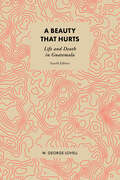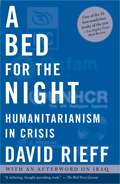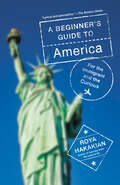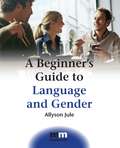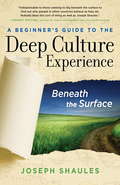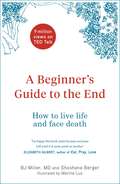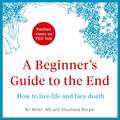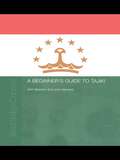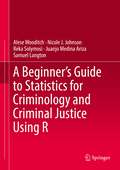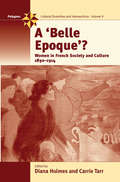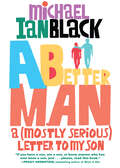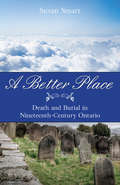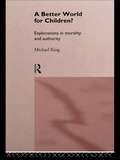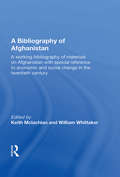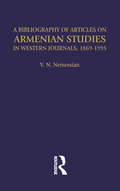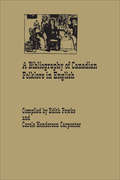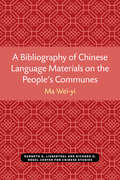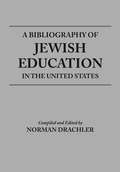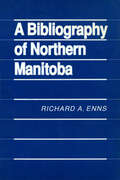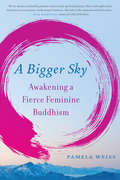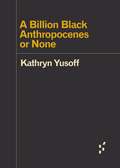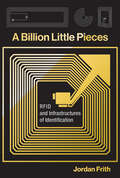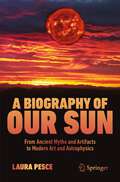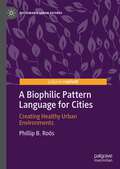- Table View
- List View
A Beauty that Hurts: Life and Death in Guatemala
by W. George LovellWhen A Beauty That Hurts first appeared in 1995, Guatemala was one of the world’s most flagrant violators of human rights. An accord brokered by the United Nations brought a measure of peace after three decades of armed conflict, but the country’s troubles are far from over. George Lovell revisits Guatemala to grapple once again with the terror inflicted on its Maya peoples by a military-dominated state.
A Bed for the Night: Humanitarianism in Crisis
by David RieffTimely and controversial, A Bed for the Night reveals how humanitarian organizations are often betrayed and misused, and have increasingly lost sight of their purpose. Drawing on firsthand reporting from war zones around the world, David Rieff shows us what aid workers do in the field and the growing gap between their noble ambitions and their actual capabilities for alleviating suffering. He describes how many humanitarian organizations have moved from their founding principle of neutrality, which gave them access to victims, to encouraging the international community to take action to stop civil wars and ethnic cleansing. By calling for intervention, humanitarian organizations risk being seen as taking sides in a conflict and thus jeopardizing their access to victims. And by overreaching, the humanitarian movement has allowed itself to be hijacked by the major powers. Rieff concludes that if humanitarian organizations are to do what they do best -- alleviate suffering -- they must reclaim their independence.
A Beginner's Guide to America: For the Immigrant and the Curious
by Roya HakakianA stirring, witty, and poignant glimpse into the bewildering American immigrant experience from someone who has lived it. Also, a mirror held up to America.Into the maelstrom of unprecedented contemporary debates about immigrants in the United States, this perfectly timed book gives us a portrait of what the new immigrant experience in America is really like. Written as a "guide" for the newly arrived, and providing "practical information and advice," Roya Hakakian, an immigrant herself, reveals what those who settle here love about the country, what they miss about their homes, the cruelty of some Americans, and the unceasing generosity of others. She captures the texture of life in a new place in all its complexity, laying bare both its beauty and its darkness as she discusses race, sex, love, death, consumerism, and what it is like to be from a country that is in America's crosshairs. Her tenderly perceptive and surprisingly humorous account invites us to see ourselves as we appear to others, making it possible for us to rediscover our many American gifts through the perspective of the outsider. In shattering myths and embracing painful contradictions that are unique to this place, A Beginner's Guide to America is Hakakian's candid love letter to America.
A Beginner's Guide to Language and Gender
by Allyson JuleA Beginner's Guide to Language and Gender offers a broad and accessible introduction to the study of gender and language use for those new to the subject. The book introduces the theoretical and practical perspectives, including relevant frameworks necessary to understand ways in which language interacts with gender/sex in various settings, including: in media, in schools, in places of business, in places of worship, and at home.
A Beginner's Guide to the Deep Culture Experience: Beneath the Surface
by Joseph ShaulesWhen we leave and travel abroad, for pleasure or for business, we make a choice: to have a superficial “airport experience” at our destination, or to appreciate the hidden culture beneath the surface. A Beginner’s Guide to the Deep Culture Experience proposes a deep culture journey, encouraging travelers to pursue a meaningful cross-cultural experience. Sharing anthropologist Edward Hall’s conviction that becoming aware of our unconscious cultural programming is a transcendental challenge facing us all, author Joseph Shaules shows how the “deep culture experience” can teach us about ourselves. This practical book is an accessible introduction to intercultural communication without buzz words, theory or abstraction. If you travel internationally for work or simply enjoy the diverse cultures of the world, read this inspirational book before your next trip.
A Beginner's Guide to the End: How to Live Life to the Full and Die a Good Death
by Shoshana Berger BJ Miller"I wish I'd had this book when I needed it. Death and dying are not subjects that many people are comfortable talking about, but it's hugely important to be as prepared as you can be - emotionally, physically, practically, financially, and spiritually. This book may be the most important guide you could have." - Elizabeth Gilbert, author of Eat Pray Love ___________The end of a life can often feel like a traumatic, chaotic and inhuman experience. In this reassuring and inspiring book, palliative care physician Dr BJ Miller and writer Shoshana Berger provide a vision for rethinking and navigating this universal process. There are plenty of self-help books for mourners, but nothing in the way of a modern, approachable and above all useful field guide for the living. And all of us - young, old, sick and well - could use the help. After all, pregnant couples have ample resources available to them as they prepare to bring a new life into the world: Lamaze courses, elaborate birth plans, tons of manuals. Why don't we have a What to Expect When You're Expecting to Die book?An accessible, beautifully designed and illustrated companion, A Beginner's Guide to the End offers a clear-eyed and compassionate survey of the most pressing issues that come up when one is dying, and will bring optimism and practical guidance to empower readers with the knowledge, resources and tools they'll need to die better, maybe even with triumph.
A Beginner's Guide to the End: How to Live Life to the Full and Die a Good Death
by Shoshana Berger BJ Miller"I wish I'd had this book when I needed it. Death and dying are not subjects that many people are comfortable talking about, but it's hugely important to be as prepared as you can be - emotionally, physically, practically, financially, and spiritually. This book may be the most important guide you could have." - Elizabeth Gilbert, author of Eat Pray Love ___________The end of a life can often feel like a traumatic, chaotic and inhuman experience. In this reassuring and inspiring book, palliative care physician Dr BJ Miller and writer Shoshana Berger provide a vision for rethinking and navigating this universal process. There are plenty of self-help books for mourners, but nothing in the way of a modern, approachable and above all useful field guide for the living. And all of us - young, old, sick and well - could use the help. After all, pregnant couples have ample resources available to them as they prepare to bring a new life into the world: Lamaze courses, elaborate birth plans, tons of manuals. Why don't we have a What to Expect When You're Expecting to Die book?An accessible, beautifully designed and illustrated companion, A Beginner's Guide to the End offers a clear-eyed and compassionate survey of the most pressing issues that come up when one is dying, and will bring optimism and practical guidance to empower readers with the knowledge, resources and tools they'll need to die better, maybe even with triumph. (P) 2019 Simon & Schuster
A Beginners' Guide to Tajiki
by Azim Baizoyev John HaywardThis is a conversational approach to the teaching and learning of the Tajiki language. It uses authentic language material to help learners as they proceed through its topic-based lessons. Its emphasis on the spoken language promotes oral fluency alongside written skills. Both lessons and appendices present new vocabulary and grammar simply and recycle material to provide opportunities for both controlled and free language learning.The appendices include not only lists of useful information and samples of commonly needed letters and speeches but also an invaluable introduction to Tajiki grammar and a comprehensive Tajiki-English dictionary of all the book's vocabulary - over 4500 definitions.
A Beginner’s Guide to Statistics for Criminology and Criminal Justice Using R
by Alese Wooditch Nicole J. Johnson Reka Solymosi Juanjo Medina Ariza Samuel LangtonThis book provides hands-on guidance for researchers and practitioners in criminal justice and criminology to perform statistical analyses and data visualization in the free and open-source software R. It offers a step-by-step guide for beginners to become familiar with the RStudio platform and tidyverse set of packages. This volume will help users master the fundamentals of the R programming language, providing tutorials in each chapter that lay out research questions and hypotheses centering around a real criminal justice dataset, such as data from the National Survey on Drug Use and Health, National Crime Victimization Survey, Youth Risk Behavior Surveillance System, The Monitoring the Future Study, and The National Youth Survey. Users will also learn how to manipulate common sources of agency data, such as calls-for-service (CFS) data. The end of each chapter includes exercises that reinforce the R tutorial examples, designed to help master the software as well as to provide practice on statistical concepts, data analysis, and interpretation of results. The text can be used as a stand-alone guide to learning R or it can be used as a companion guide to an introductory statistics textbook, such as Basic Statistics in Criminal Justice (2020).
A Belle Epoque?
by Diana Holmes Carrie tarrThe Third Republic, known as the 'belle époque', was a period of lively, articulate and surprisingly radical feminist activity in France, borne out of the contradiction between the Republican ideals of liberty, equality and fraternity and the reality of intense and systematic gender discrimination. Yet, it also was a period of intense and varied artistic production, with women disproving the critical nearconsensus that art was a masculine activity by writing, painting, performing, sculpting, and even displaying an interest in the new "seventh art" of cinema. This book explores all these facets of the period, weaving them into a complex, multi-stranded argument about the importance of this rich period of French women's history.
A Better Man: A (Mostly Serious) Letter to My Son
by Michael Ian Black&“Raw, intimate, and true . . . A Better Man cracked me wide open, and it&’s a template for the conversation we need to be having with our boys.&” —Peggy Orenstein, bestselling author of Boys & Sex A poignant look at boyhood, in the form of a heartfelt letter from comedian Michael Ian Black to his teenage son before he leaves for college, and a radical plea for rethinking masculinity and teaching young men to give and receive love. In a world in which the word masculinity now often goes hand in hand with toxic, comedian, actor, and father Michael Ian Black offers up a way forward for boys, men, and anyone who loves them. Part memoir, part advice book, and written as a heartfelt letter to his college-bound son, A Better Man reveals Black&’s own complicated relationship with his father, explores the damage and rising violence caused by the expectations placed on boys to &“man up,&” and searches for the best way to help young men be part of the solution, not the problem. &“If we cannot allow ourselves vulnerability,&” he writes, &“how are we supposed to experience wonder, fear, tenderness?&” Honest, funny, and hopeful, Black skillfully navigates the complex gender issues of our time and delivers a poignant answer to an urgent question: How can we be, and raise, better men?
A Better Place: Death and Burial in Nineteenth-Century Ontario
by Susan SmartA Better Place describes the practices around death and burial in 19th-century Ontario. Funeral rituals, strong religious beliefs, and a firm conviction that death was a beginning not an end helped the bereaved through their times of loss in a century where death was always close at hand.The book describes the pioneer funeral in detail as well as the factors that changed this simple funeral into the elaborate etiquette-driven Victorian funeral at the end of the century. It includes the sources of various funeral customs, including the origins of embalming that gave rise to the modern-day funeral parlour. The evolution of cemeteries is explained with the beginnings of cemeteries in specific towns given as examples.An understanding of these changing burial rites, many of which might seem strange to us today, is invaluable for the family historian. In addition, the book includes practical suggestions for finding death and burial records throughout the century.
A Better World for Children?: Explorations in Morality and Authority
by Michael KingBy exploring such diverse issues as the management of child abuse, legal reforms following sex abuse enquiries, moral explanations for the actions of child murderers, the impossible task faced by social workers and the limitations of children's rights campaigns, Michael King examines the revolutionary ideas of the social theorist, Niklas Luhmann. He demonstrates how Luhmann's theory of authopoietic systems compels readers to re-examine exactly what they mean by society. Questioning the relationship between personal morality and political will, it challenges the assumption that changing society is merely a matter of changing attitudes and highlights the pitfalls associated with formulating social reform.
A Bibliography Of Afghanistan
by K. S. McLachlanThis up-to-date, comprehensive, thematically indexed bibliography devoted to Afghanistan now and yesterday will help readers to efficiently find their way in the massive secondary literature available. Following the pattern established by one of its major data sources, viz. the acclaimed Index Islamicus, both journal articles and book publications are included and expertly indexed. An indispensable entry for all those taking professional or personal interest in a nation so much the focus of attention today.
A Bibliography of Articles on Armenian Studies in Western Journals, 1869-1995 (Caucasus World)
by Vrej N Nersessian Vrej N. NersessianCovers a comprehensive range of periodicals - well over 165 in all.
A Bibliography of Canadian Folklore in English
by Edith Fowke Carole Henderson-CarpenterThis book is the only comprehensive bibliography of Canadian folklore in English. The 3877 different items are arranged by genres: folktales; folk music and dance; folk speech and naming; superstitions, popular beliefs, folk medicine, and the supernatural; folk life and customs; folk art and material culture; and within genres by ethnic groups: Anglophone and Celtic, Francophone, Indian and Inuit, and other cultural groups. The items include reference books, periodicals, articles, records, films, biographies of scholars and informants, and graduate theses. Each items is annotated through a coding that indicates whether it is academic or popular, its importance to the scholar, and whether it is suitable for young people. The introduction includes a brief survey of Canadian folklore studies, putting this work into academic and social perspective. The book covers all the important items and most minor items dealing with Canadian folklore published in English up to the end of 1979. It is concerned with legitimate Canadian folklore – whether transplanted from other countries and preserved here, or created here to reflect the culture of this country. It distinguishes between authentic folklore presented as collected and popular treatments in which the material has been rewritten by the authors. Intended primarily for scholars of folklore, international as well as Canadian, the book will also be of use to scholars in anthropology, cultural geography, oral history, and other branches of Canadian culture studies, as well as to librarians, teachers, and the general public.
A Bibliography of Chinese Language Materials on the People's Communes (Michigan Monographs In Chinese Studies #44)
by Wei-Yi MaA research tool for scholars studying modern China, particularly those focusing on the post-1949 communal system and economy. The work includes full bibliographic references to some 2,800 essay, articles, pamphlets, and other materials in Chinese taken from more than 130 publications, primarily from mainland. The entries are arranged are arranged topically with annotations. Includes a geographic index to the communes referred to in the listed items.
A Bibliography of Jewish Education in the United States
by Norman DrachlerThis book contains entries from thousands of publications whether in English, Hebrew, Yiddish, and German—books, research reports, educational and general periodicals, synagogue histories, conference proceedings, bibliographies, and encyclopedias—on all aspects of Jewish education from pre-school through secondary education
A Bibliography of Northern Manitoba
by Richard A. EnnsMuch has been written about the history and the people of northern Manitoba, but until now this body of work has not been readily accessible to the researcher or teacher. This bibliography identifies published sources, such as books and magazine and journal articles, as well as unpublished sources that are available to the public, including academic theses and government pamphlets, reports, and studies. It includes primarily materials dealing with the area north of 53rd parallel of latitude, but it also includes material on the area east of Lake Winnipeg as far south as the 51st parallel, a region that is similar to the North. References are listed under seven topics: bibliographies and research aids; the fur trade; Aboriginal and Métis populations; exploration and travel accounts; church and mission histories; northern geography and resources; and community histories and twentieth century resource exploitation.
A Bigger Sky: Awakening a Fierce Feminine Buddhism
by Pamela WeissReimagining Buddhism through a feminine lens: A powerful memoir of healing, strength, and spiritual awakening.Written by the first and only layperson to receive full dharma transmission in the Suzuki Roshi Soto Zen lineage, A Bigger Sky explores what it means to traverse the gaps of a Buddhism created by and for men, navigate the seemingly contradictory domains of secular and spiritual life, and walk a path through the heart of the world. Blending memoir, Buddhist practice, and cultural observation, Weiss reorients Buddhism through a wider and more inclusive feminine lens. Her personal and spiritual journey speaks to the bits of brokenness in us all, shining a light on the different pathways we can walk to become whole. Through beautifully crafted prose, Weiss shares what it means to be an ordinary Bodhisattva, describing how the Buddha's profound vision of freedom can be lived outside of institutions and rule-bound practice to support us in deepening our connection with ourselves, each other, and the planet. A Bigger Sky illuminates how integrating a more feminine approach to Buddhist teachings can be applied in spiritual practice, community, relationships, and day-to-day life.
A Billion Black Anthropocenes or None (Forerunners: Ideas First)
by Kathryn YusoffRewriting the &“origin stories&” of the Anthropocene No geology is neutral, writes Kathryn Yusoff. Tracing the color line of the Anthropocene, A Billion Black Anthropocenes or None examines how the grammar of geology is foundational to establishing the extractive economies of subjective life and the earth under colonialism and slavery. Yusoff initiates a transdisciplinary conversation between feminist black theory, geography, and the earth sciences, addressing the politics of the Anthropocene within the context of race, materiality, deep time, and the afterlives of geology. Forerunners is a thought-in-process series of breakthrough digital works. Written between fresh ideas and finished books, Forerunners draws on scholarly work initiated in notable blogs, social media, conference plenaries, journal articles, and the synergy of academic exchange. This is gray literature publishing: where intense thinking, change, and speculation take place in scholarship.
A Billion Little Pieces: RFID and Infrastructures of Identification (Infrastructures)
by Jordan FrithHow RFID, a ubiquitous but often invisible mobile technology, identifies tens of billions of objects as they move through the world.RFID (Radio Frequency Identification) is ubiquitous but often invisible, a mobile technology used by more people more often than any flashy smartphone app. RFID systems use radio waves to communicate identifying information, transmitting data from a tag that carries data to a reader that accesses the data. RFID tags can be found in credit cards, passports, key fobs, car windshields, subway passes, consumer electronics, tunnel walls, and even human and animal bodies—identifying tens of billions of objects as they move through the world. In this book, Jordan Frith looks at RFID technology and its social impact, bringing into focus a technology that was designed not to be noticed.RFID, with its ability to collect unique information about almost any material object, has been hyped as the most important identification technology since the bar code, the linchpin of the Internet of Things—and also seen (by some evangelical Christians) as a harbinger of the end times. Frith views RFID as an infrastructure of identification that simultaneously functions as an infrastructure of communication. He uses RFID to examine such larger issues as big data, privacy, and surveillance, giving specificity to debates about societal trends. Frith describes how RFID can monitor hand washing in hospitals, change supply chain logistics, communicate wine vintages, and identify rescued pets. He offers an accessible explanation of the technology, looks at privacy concerns, and pushes back against alarmist accounts that exaggerate RFID's capabilities. The increasingly granular practices of identification enabled by RFID and other identification technologies, Frith argues, have become essential to the working of contemporary networks, reshaping the ways we use information.
A Biographical Dictionary of Ancient Egypt (Seaby Biographical Dictionaries Ser.)
by Anthony E. DavidImportant historical and cultural figures as well as some well-known individuals in Egypt's long history (c 3100 BC - c AD 600) are incorporated in this work of reference. Rulers and members of their families, significant figures and important foreigners with whom the Egyptians came into contact are all included. The entries are based on original source material and there are bibliographies for each entry.
A Biography of Our Sun: From Ancient Myths and Artifacts to Modern Art and Astrophysics
by Laura PesceThis book is for everyone curious about the Sun and how it has been perceived throughout human history, including the modern scientific view. Beginning with ancient myths and legends, superstitions, art and poetry, the book proceeds to explain the amazing composition of our star, how it produces the heat and light on which all life depends, as well as touching the harvesting of solar energy that is becoming so essential in the modern world. The book is illustrated by the author's own artwork and includes first-hand scientific information provided in interviews with professional astrophysicists.
A Biophilic Pattern Language for Cities: Creating Healthy Urban Environments (Sustainable Urban Futures)
by Phillip B. RoӧsThis book presents a holistic integral sustainable design and planning method embedded in the hypothesis of biophilia, our innate connection to nature, used as a platform to chart a biophilic pattern language framework. In A Biophilic Pattern Language for Cities, the author positioned the innate human-nature connection as critical in biophilic design and sustainable city planning solutions.
